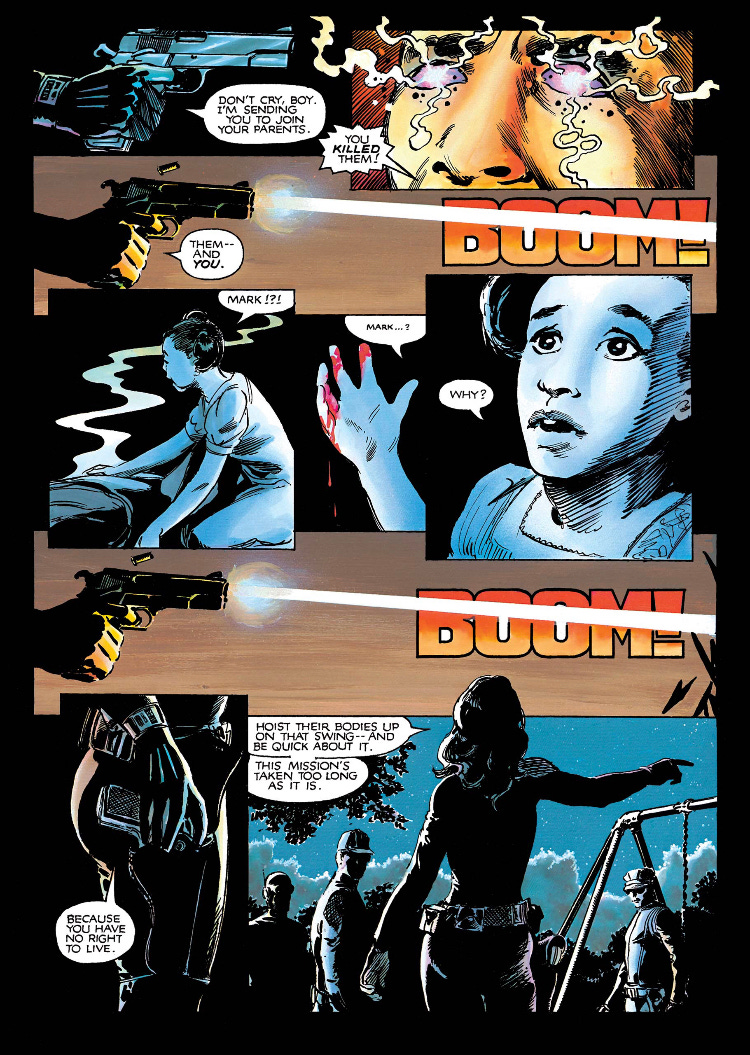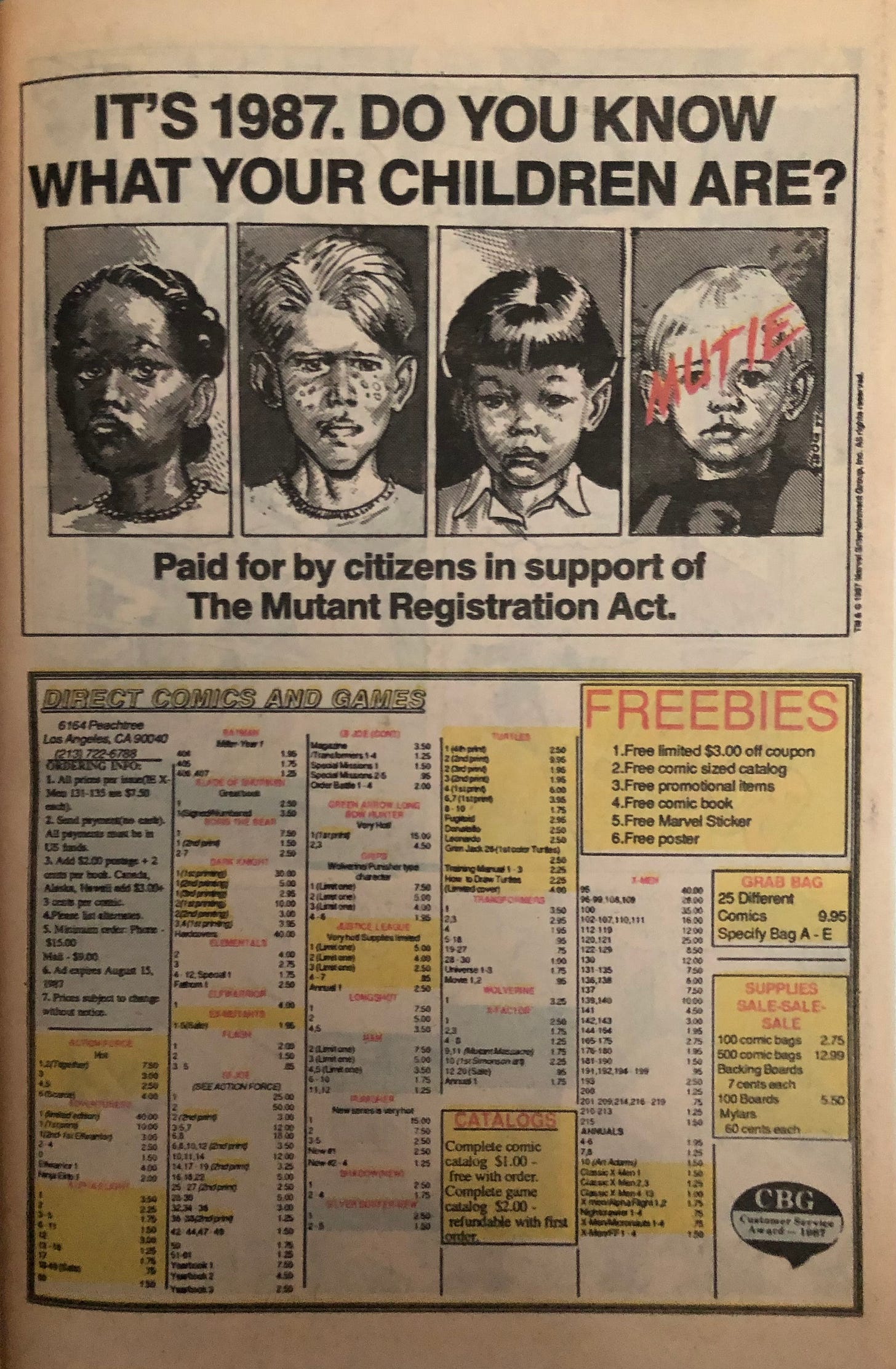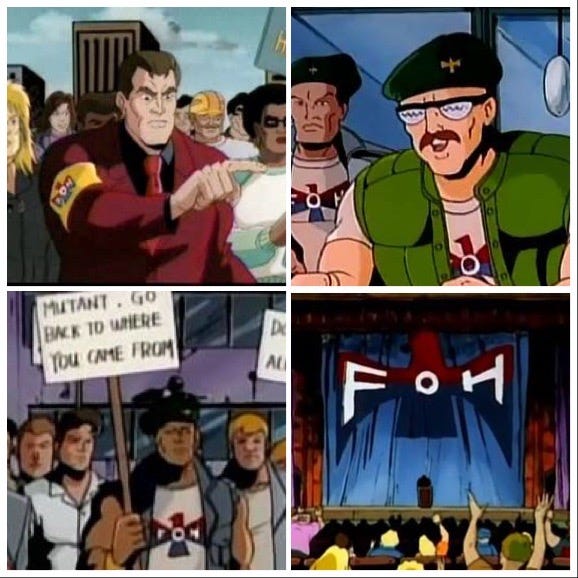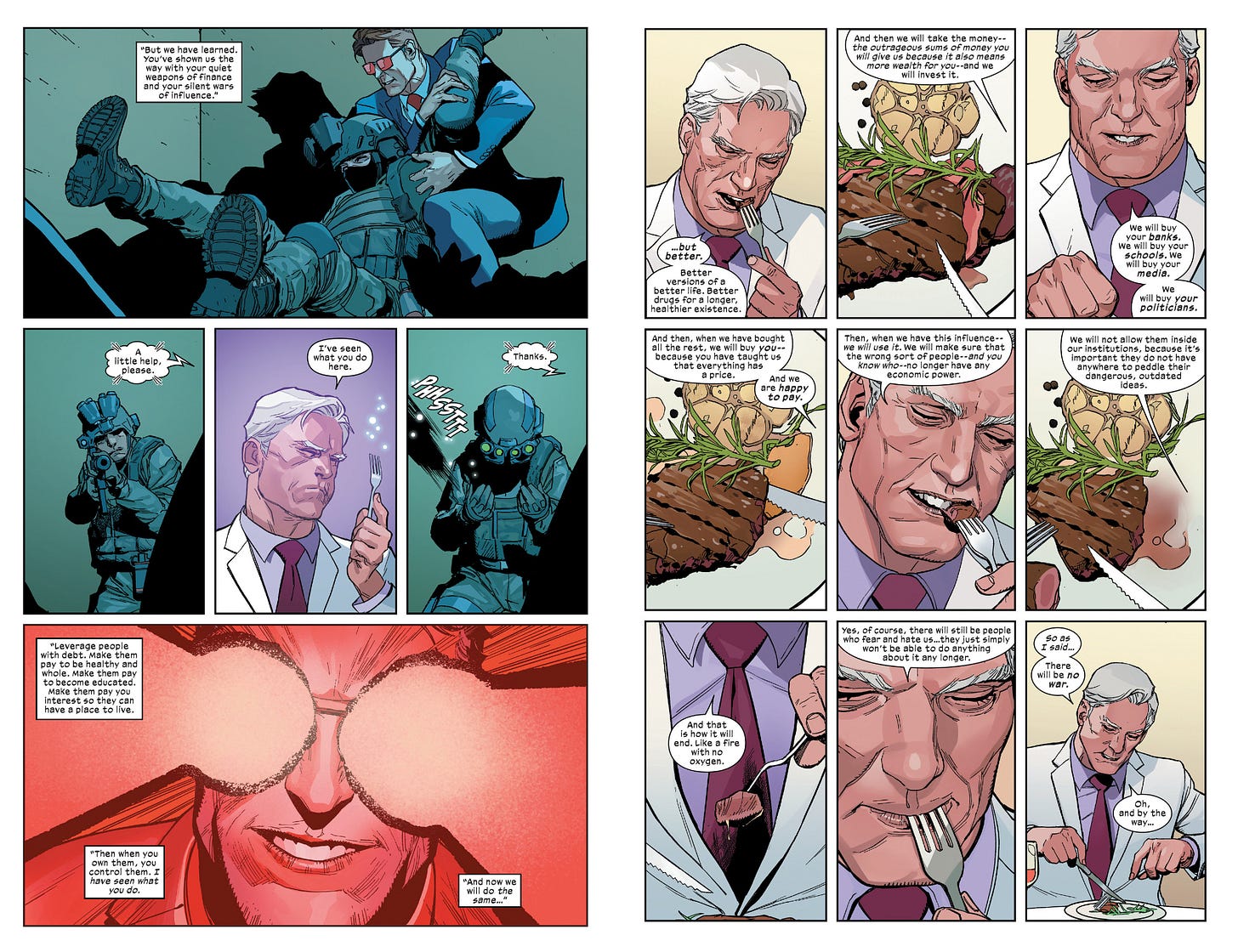Yes, the X-Men Have Always Been Political
Get ready for a new wave of terrible takes once mutants are prominent in the MCU
If you’ve been keeping up with the latest developments in the Marvel Cinematic Universe (henceforth referred to as the MCU in this piece), then it has become pretty clear that the X-Men will soon be added to the long list of Marvel characters currently inhabiting that world. It’s impossible to know exactly how those characters will be portrayed once they debut, but one thing is an absolute certainty: there will be people who complain that Disney has made the X-Men “woke” and “political.” I know this will happen because it happens anytime Disney releases a new film or streaming series whether it be a Marvel property, Star Wars property, or Pixar property. If you engage with any pop culture related YouTube videos, you’re bound to be bombarded with recommendations for a seemingly infinite number of videos criticizing people for injecting politics into the previously chaste and unspoiled properties that they enjoyed as children. Don’t believe me? Do a quick YouTube search of any film, show, comic book, etc. “+ woke” and see what happens. Actually, don’t do that. It can’t be good for your mental health. The point is there is a cottage industry of “content creators” who do nothing but churn out angry videos about how the things they loved as children have been ruined by “going woke.” The X-Men are not immune from this, and their eventual introduction into the MCU will only increase the number of these types of videos. The irony, of course, is that the X-Men have always been political in nature since their very inception by Stan Lee and Jack Kirby in 1963. I plan on breaking down how various creators have utilized the X-Men to serve as an allegory for various political issues over the course of decades. The next time someone complains about the X-Men being “ruined” because of politics and “SJW’s,” just send them this piece.
Stan Lee has gone on record numerous times over the years to explain that the X-Men were intended to serve as an allegory for the Civil Rights movement in the United States. In an interview with Rolling Stone in 2018, he said the following:
Oh, I was just gonna say, but my favorite villain was Magneto. And I loved the idea of the X-Men being good mutants, and then we’d get a bunch of bad mutants, and we’d make it seem as if the bad mutants had a point there. The human race hated them and feared them and shunned them and was trying to get rid of them, so why should they take it laying down? Why didn’t they fight back?
Whereas Professor Xavier said, we’ve gotta all learn to live together, no matter how different we are. And I felt that represented some schools of thought that exist among the human race now. And it was fun to toy with that concept. And basically, the main idea was to show that bigotry is really a terrible thing, and we should all get along with each other no matter how different we are. That was the main objective. If you needed an objective for a superhero story.
Seems pretty straightforward if you ask me. Unfortunately, Uncanny X-Men (originally just titled X-Men) wasn’t selling very well and was canceled in 1970. This is purely speculation on my end, but I wonder if it might have been because having five wealthy white teenagers attending a prestigious private school serve as a metaphor for oppressed minority groups didn’t quite click with folks at the time.
Regardless of why the series was initially canceled, the X-Men brand was eventually rebooted in 1975 with the publication of Giant-Size X-Men #1 by Len Wein and Dave Cockrum. This new team was composed of a variety of brand new characters from every corner of the globe which meant it was much more racially diverse. Uncanny X-Men relaunched that same year with Cockrum remaining on art duties and Chris Claremont taking over for Wein as writer. Claremont would stay on as writer for an extraordinary sixteen year run that would see the X-Men become the most popular and bestselling characters that Marvel was publishing. It was during this time that they would also become much more explicitly used as metaphors for oppressed minority groups and take on challenges pulled directly from real world events.
The 1980s in particular were when Claremont really began focusing on more politically driven stories. The “Days of Future Past” arc in Uncanny X-Men #141-142 in 1981 told the story of a possible future where the assassination of an anti-mutant politician resulted in the government fully funding the Sentinel program (giant robots designed to hunt down anyone with the mutant X-gene) that led to a full blown genocide of mutants. Later that same year in Uncanny X-Men #150, it was revealed that Magneto (the primary villain of the X-Men throughout the Silver Age of the 1960s) was a Jewish Holocaust survivor whose family had been killed. The character immediately went from a hammy Silver Age villain to a tragic figure who had a compelling reason for why he was so determined to fight for global mutant liberation. Claremont also penned a graphic novel illustrated by Brent Anderson in 1982 called X-Men: God Loves, Man Kills where a popular televangelist named Reverend William Stryker funds a right-wing death squad called the Purifiers whose objective is the murder of every mutant man, woman, and child on the planet. The opening sequence sees these Purifiers kill two mutant children and string up their bodies on a playground for all to see. Yeah, I would say that is a political statement.

Claremont (along with artist Rick Leonardi) would go on to introduce the island nation of Genosha in 1988’s Uncanny X-Men #235. This fictional nation was located off the coast of Southern Africa and boasted a high standard of living along with strong economic power (along with a predominantly white ruling class). The dirty little secret of Genosha was that it was an apartheid state where mutants were a subclass that was forced into manual labor to prop up the wealthy ruling class. Get it? It’s a stand in for apartheid South Africa.
Claremont wasn’t the only one writing politically charged X-Men stories in the 1980s. Louise Simonson (who had replaced original writer Bob Layton) had been writing a parallel series called X-Factor with her husband Walt Simonson on art duties. One of the primary antagonists throughout her run was Cameron Hodge who founded a mutant hunting death squad in X-Factor #21 (published in 1987) called The Right. Huh. A death squad hunting minority groups called The Right? Surely nothing political going on there!
Hodge and The Right would remain major villains for not just X-Factor but the X-Men and New Mutants as well for years. He would also go on to work closely with the aforementioned Genoshan government.
So I think it’s pretty well established at this point that the 1980s were filled with X-Men storylines that were extremely political in nature. But what about the 1990s? That’s when the X-Men brand reached its apex in popularity. It’s also when the animated series debuted and became a major phenomenon. Surely both the comics and animated series ditched the politics in favor of kid friendly adventure stories, right? Well let’s take a look! The first major X-Men comics crossover event of the 1990s was “X-Tinction Agenda.” This crossover prominently featured artwork by Jim Lee and Rob Liefeld, two of the most ‘90s artists to ever ‘90s who would later go on to found Image Comics. Comics at this time are often thought of as being shallow and relying on an excess of sex and violence. So what was “X-Tinction Agenda” about? It was about the various mutant teams at the time fighting to overthrow the anti-mutant apartheid regime in Genosha. Huh. I guess that is a tad political in nature.
Surely no other stories or crossovers in the ‘90s were like that, right? Well in 1993, the Legacy Virus was introduced. It was a virus that specifically infected mutants and was always fatal. The rest of the world looked away and did nothing as it ravaged mutant communities. It’s a pretty obvious analog for HIV and the way it was ignored when it was perceived as only impacting the gay community. There was also the “Phalanx Covenant” crossover in 1994 about Cameron Hodge and his bigoted followers joining forces with an alien hive mind to exterminate all mutants. Later in 1997 there was an event called “Operation: Zero Tolerance” in which elements of the United States government worked with a group of Prime Sentinels led by the sentient Sentinel known as Bastion to “solve the mutant problem” by capturing and exterminating them en masse following the assassination of anti-mutant Presidential candidate Graydon Creed. Nothing political about that!
Okay. Politics may have found its way into the comics in the ‘90s, but surely the beloved animated series didn’t dabble in such things! I mean there are literally dozens of YouTube videos already bemoaning that the relaunch of the series on Disney+ will ruin everything by becoming woke! The sanctity of the completely politics-free original series must be protected, right? Well, remember when I mentioned Graydon Creed in the previous paragraph dealing with comics in the ‘90s? He was actually a far bigger deal in the animated series than he was in the comics. In the animated series, he was the leader of an organization called the Friends of Humanity. This was a full blown fascist militia that patrolled the streets of America looking for mutants to violently assault and murder. Seriously. They are even drawn with blatantly fascist aesthetics including arm bands with their logo. Just look at some of these images!
I don’t think the show runners could have been more blatant with their intentions if they tried. There’s even a moment where they corner a terrified mutant with no powers, and it’s implied that they murder him. It’s extremely upsetting stuff!
Things were no different in the 2000s. Grant Morrison’s 2001 New X-Men run with Frank Quitely opened with Sentinels committing a genocide that resulted in the deaths of over sixteen million mutants. Mark Millar’s Ultimate X-Men run with Adam Kubert the same year began with Sentinels murdering a young mutant and his dog in the middle of New York City. The feature film X-Men in 2000 revolves around the United States Congress on the verge of passing the Mutant Registration Act, and 2003’s X2: X-Men United is an adaptation of the previously mentioned X-Men: God Loves, Man Kills graphic novel from 1982. Even Chris Claremont got back into the act in his X-Treme X-Men series with artist Igor Kordey when he began his “God Loves, Man Kills II” story in 2003. My point is the 2000s were filled with political commentary in multiple X-Men comics as well as the films. It was impossible to avoid.
The 2010s were a bit of a dark period for X-Men fans as Marvel was intentionally burying the comics out of spite for 20th Century Fox holding the film rights instead of Marvel Studios and Disney. That changed in 2019 when Jonathan Hickman along with artists Pepe Larraz and R.B. Silva launched the companion series House of X and Powers of X. The driving narrative of House of X in particular is that mutants (led by Xavier and Magneto) have established a mutant nation-state along with a governmental body and laws, and they are now major players on the global political stage as they deal not just with anti-mutant hate groups but also various world governments. In 2020’s X-Men #4 by Hickman and artist Leinil Francis Yu, a mutant delegation composed of Xavier, Magneto, and Apocalypse travel to Davos for the World Economic Forum (a real world event) to meet with world leaders and discuss the political and economic future of the mutant nation-state of Krakoa. I cannot think of a more explicitly political moment than this.
Needless to say, real world politics have been an integral part of the X-Men since their debut in the 1960s, and it has remained so up to this very day. It is a part their DNA so to speak. It will certainly be a part of any future adaptations including however they are used in the MCU. When the usual folks begin ranting and raving about how the brand has been ruined by “going woke,” “getting political,” or some other such nonsense, just remember that they are either liars or lack the most basic reading comprehension imaginable. Ignore them and enjoy the ride.








